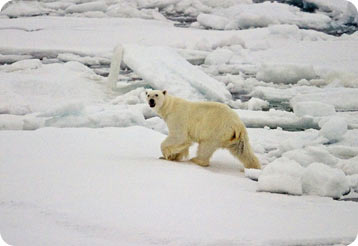The chilly waters that separate the northern coasts of Alaska and Siberia are some of the liveliest in the world. They teem with everything from algae to polar bears. Yet life there is changing in a hurry. And scientists are paying close attention.
 The chilly waters of the Chukchi Sea teem with everything from algae to polar bears. Credit: National Oceanic and Atmospheric Administration
The chilly waters of the Chukchi Sea teem with everything from algae to polar bears. Credit: National Oceanic and Atmospheric AdministrationThe region is known as the Chukchi Sea. It covers an area as big as Texas. Most of its shallow waters support abundant life, including some of the world’s largest populations of polar bears, Pacific walruses, and other marine mammals.
But life is getting harder for these creatures. Much of the ice that used to cover the Chukchi even during the summer has vanished. Without the ice to support them, many of the mammals have to swim farther to find food, and more of them crowd onto the shore; more about that in our next program.
Another potential challenge is offshore drilling. In 2009, the federal government awarded leases for millions of acres of seafloor, although a judge halted drilling plans earlier this year.
Over the last two summers, a government-sponsored research team has plied the Chukchi to learn more about it. The scientists measured water temperatures, currents, and salinities. They collected water samples, along with fish and shellfish, and they monitored marine mammals. Industry-sponsored researchers have also studied the Chukchi. One of their goals is to provide baseline data that’ll help assess the impact of drilling.
This work will help us understand how life is changing in the chilly waters of the Chukchi Sea.

